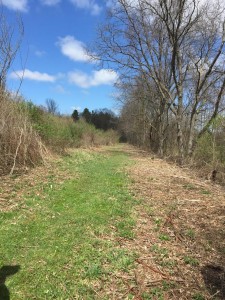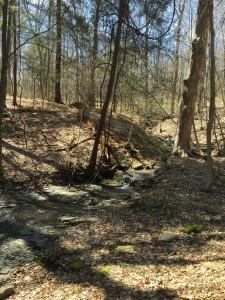On a hike at the Fischer Old-Growth Forest last weekend I discovered a parcel of history that revealed a story much older than Cornell’s. A small group of students joined Todd Bittner, the Director of Natural Areas for Cornell Plantations, on a short drive from campus to the forest, which is nested away from the roadside. We stopped at what seemed to be an arbitrary location, but actually turned out to be the foundation of what used to be a barn. Throughout the walk, I was surprised to realize that once you’re told what to look for, clues about the past become evident and meaningful. For instance, part of the old-growth forest was cleared to make room for farming. The transition between recent invasive shrubs, younger trees, and finally, trees that have never been logged became obvious along the walk as we progressed deeper into the forest. Other landmarks, such as stone walls and sudden changes in micro-topography and elevation can also be used to identify the age of trees and past land use, much more so even than tree height. This is due to sporadic growth in good conditions that makes height an unreliable predictor of a tree’s age. We also learned about the formation of the entire region during the last ice age, which carved the steep slopes of the forest, while river deltas left behind small, flat areas where sediment collected. Since being saved from logging several decades ago, the old-growth forest, the best representation of its kind in Tompkins county, has served as an outdoor classroom, eventually being acquired by Cornell for this purpose. Below you can see a few of the beautiful sites that we passed through. Overall, it was a very fun experience and a great way to learn more about this region’s natural history.
2 thoughts on “Deep-Rooted Histories”
Leave a Reply
You must be logged in to post a comment.




This seems like it was such a fun event! Like I said on another comment, Cornell has such a rich history that most of us aren’t privy to unless we go out searching for it. I’m spending my summer here on campus, and I’m so excited to learn all that I can about this school that we go to.
Anna-Katharina, I liked how you discussed what the trees and land formation can tell us about the past. I would be curious to know if Director Bittner gave some indication about the potential conditions of the forests and landscapes in the future. Having attended some of the cafe series and reading others’ blog posts this year regarding the environment and climate change, I wonder how much Tompkins County and the greater Ithaca climate might change in the next few decades. Given the odd weather and temperatures that we have had this year, hopefully, we can maintain the beauty of the Cornell campus and its surrounding landscapes for many, many, many years to come! Your pictures were a great addition to your blog post, as well.